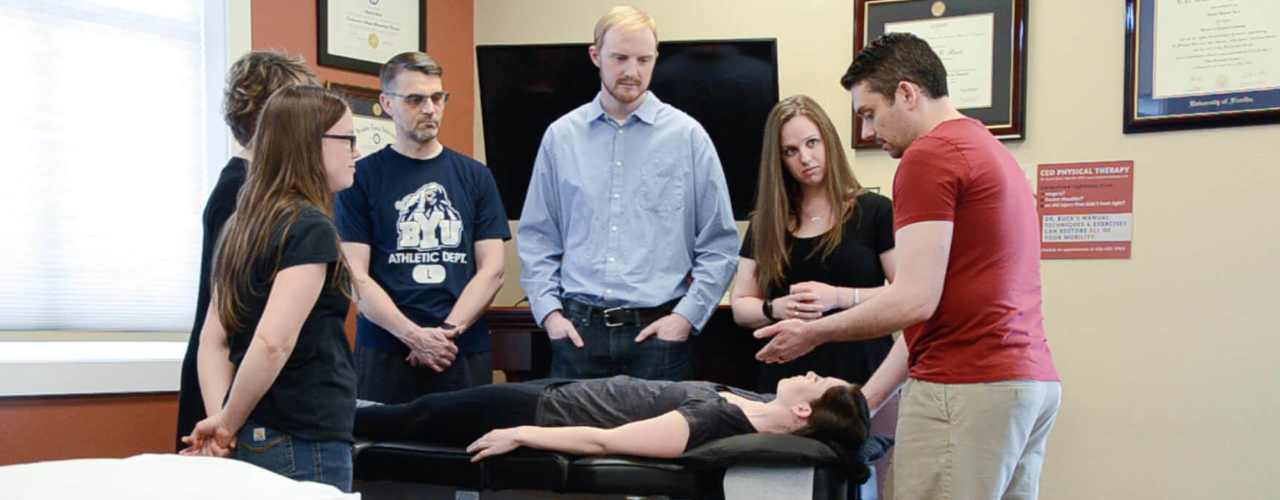This two-day course is comprised of 80% practical and 20% didactic training. The primary focus will be on the development of the psychomotor skills needed to safely and effectively deliver high-velocity, low-amplitude thrust (HVLAT) manipulation to all remaining diarthrodial and select synarthrodial joints. This will include techniques directed to the temporomandibular joint, the anterior rib articulations, and the extremities. Also provided will be a brief background of non-vertebral HVLAT, guidelines to direct appropriate use of non-vertebral HVLAT, and a review of the evidence regarding vertebral and non-vertebral HVLAT in the management of upper and lower quarter neuromusculoskeletal conditions. All IMMT HVLAT courses have been approved for 15 contact hours by PT state boards where the courses are held, as well as the Board of Certification (BOC) for athletic trainers.
HVLAT: Spine does not have to be taken prior to this course. However, the participant must review the textbook for HVLAT: Spine prior to attending this course.
All IMMT HVLAT courses have been approved for 15 contact hours by PT state boards where the courses are held, as well as the Board of Certification (BOC) for athletic trainers.
Course Objectives
At the completion of this course, the participants will be able to:
- Identify the inherent similarities and differences in high-velocity, low-amplitude thrust (HVLAT) manipulation directed to the vertebral column versus non-vertebral joints.
- Identify two physiological and accessory levers used in HVLAT techniques for the TMJ, anterior rib, and extremity articulations.
- Perform, given a patient case scenario, non-vertebral HVLAT procedures that produce an audible cavitation.
- Perform, given a patient case scenario, evidence-based examination techniques to confirm/refute the appropriateness of HVLAT for non-vertebral conditions.
- Discuss the efficacy of vertebral and non-vertebral HVLAT in the treatment of shoulder, elbow, and hand neuromusculoskeletal pathology using two peer-reviewed sources.
- Discuss the efficacy of vertebral and non-vertebral HVLAT in the treatment of hip, knee, and foot neuromusculoskeletal pathology using two peer-reviewed sources.
- Discuss the efficacy of vertebral and non-vertebral HVLAT in the treatment of TMJ and rib dysfunction using two peer-reviewed sources.
This course has been approved for 15 contact hours by all state boards where courses are held.
Course Schedule
HVLAT: Extremity | Day 1 (8 hours)
7:45 am Sign-in
8:00 am Non-Vertebral HVLAT, Efficacy of Vertebral and Non-Vertebral HVLAT for the Upper Quarter – Part 1
8:30 am HVLAT Distraction HVLAT
9:00 am Anterior Rib (Costochondral/Sternochondral) HVLAT
9:30 am Break
9:45 am Sternoclavicular, Acromioclavicular, and Glenohumeral HVLAT
11:00 am Humeroulnar, Humeroradial, and Radioulnar HVLAT
12:00 pm Lunch
1:00 pm Efficacy of Vertebral and Non-Vertebral HVLAT for the Upper Quarter – Part 2
2:00 pm Distal Radioulnar, Carpal, and Finger HVLAT
3:15 pm Break
3:30 pm Symphysis Pubis Muscle-Energy HVLAT
4:15 pm Femoroacetabular HVLAT
5:00 pm Conclusion of Day 1
HVLAT: Extremity | Day 2 (8 hours)
7:45 am Sign-in
8:00 am Efficacy of Vertebral and Non-Vertebral HVLAT for the Lower Quarter – Part 1
8:45 am Tibiofemoral HVLAT
10:00 am Break
10:15 am Subtalar HVLAT
11:15 am Proximal and Distal Tibiofibular HVLAT
12:00 pm Lunch
1:00 pm Efficacy of Vertebral and Non-Vertebral HVLAT for the Lower Quarter – Part 2; Legal/Practical Considerations of HVLAT
2:00 pm Talocrural Distraction HVLAT
3:00 pm Break
3:15 pm Midfoot HVLAT
4:15 pm Forefoot HVLAT
5:00 pm Issue Course Certificates, Conclusion of Day 2



